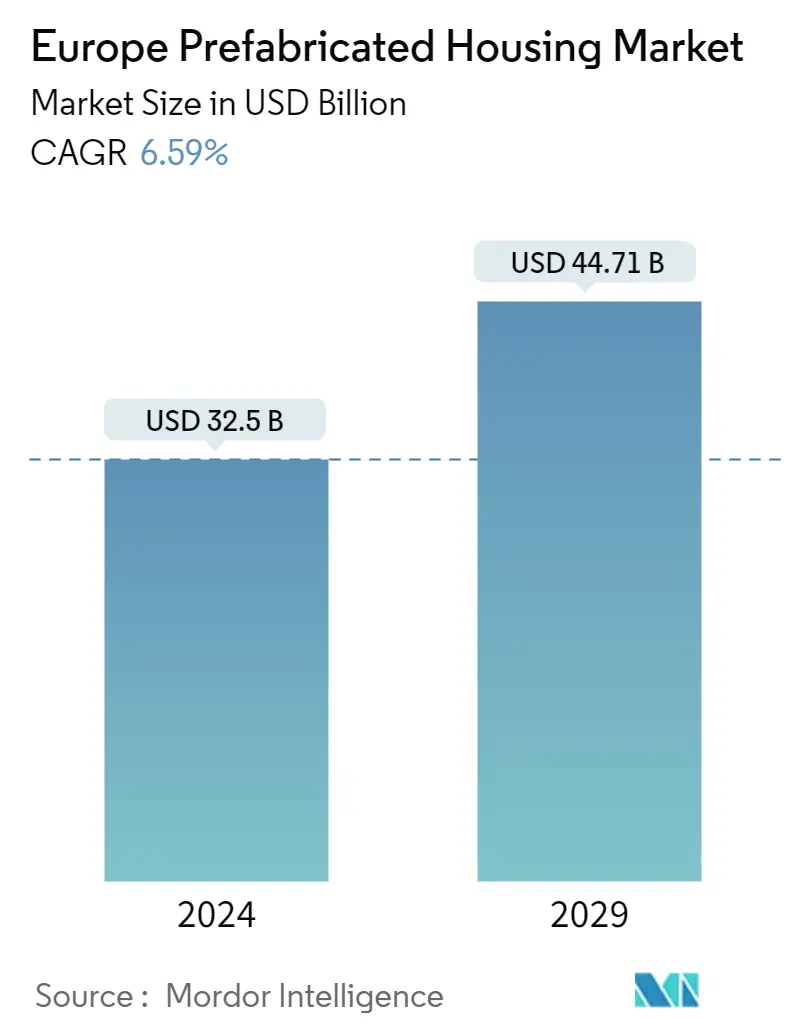Market Size of Europe Prefabricated Housing Industry

| Study Period | 2020 - 2029 |
| Base Year For Estimation | 2023 |
| Market Size (2024) | USD 32.5 Billion |
| Market Size (2029) | USD 44.71 Billion |
| CAGR (2024 - 2029) | 6.59 % |
| Market Concentration | Low |
Major Players
*Disclaimer: Major Players sorted in no particular order |
Europe Prefabricated Housing Market Analysis
The Europe Prefabricated Housing Market size is estimated at USD 32.5 billion in 2024, and is expected to reach USD 44.71 billion by 2029, growing at a CAGR of 6.59% during the forecast period (2024-2029).
The European prefabricated housing market is mainly driven by low- to mid-rise residential buildings, project homes, and public housing demand. The value of the modular construction sector in Poland has increased by almost half over the past two years as prefabricated technology is increasingly used to construct buildings. A large selection of available materials and a rise in raw material prices and labor costs have helped the process.
The construction of the two modules that make up a two-bedroom home takes only 14 days in L&G's factory. Dispatched on the back of lorries and bolted together on site, a house has staircases, windows, doorways, a fully equipped kitchen and bathroom, sockets, radiators, and a heat pump. Modular homes are in the top energy performance bracket, so they could save an average household up to GBP 800 (USD 1013.49) a year on energy bills, according to the industry group Make UK Modular. L&G aims to produce 450 homes at the factory this year but could increase this to 3,000 annually.
Another modular firm, the Goldman Sachs-backed Top Hat company, is creating its second housing site near Corby. It will be the largest 3D modular housing factory in western Europe, the size of 11 football fields. It is planning to build 4,000 homes a year.
According to Make UK Modular, by 2025, the industry will have been able to produce 20,000 prefab homes. The government has set a target of 300,000 new homes annually by 2025, representing a fifth of the 100,000 annual shortfall.
The prefabricated housing market is growing across Europe as people increasingly focus on turnkey solutions that tick all the modern boxes. The manufacturing firms' acceptance and ease of planning and consent processes are expected to boost demand further. Modular construction is gaining popularity across the European region owing to population growth and shortages in housing. It is gaining momentum as an effective means to build affordable housing.
In Italy, the demand for prefabricated, anti-seismic houses in steel is expected to gain popularity, owing to their validity and efficiency in housing safety. It is applicable, especially in those areas subjected to recurrent seismic events. Sweden is one of the world's most developed markets for prefabricated construction, with a high penetration rate.
Sweden is the leading country in implementing penalized building systems, where around 80% of its housing sector uses structures and elements prefabricated in factories. Offsite manufacturing is used in Sweden to build at least 45% of its new homes and 30% of new-build multi-residence buildings. According to an industrial study, about eight out of 10 detached houses in Sweden are built using modern methods.
Europe Prefabricated Housing Industry Segmentation
Prefabrication is the method of construction where components of a building structure are assembled either in a manufacturing or production site, transporting complete or partial assemblies to the site where the structure should be present. This work is carried out in two stages: manufacturing components in a place other than the final location and their erection in position.
The report covers a complete background analysis of the European prefabricated housing market. It includes the economic assessment and contribution of economic sectors, market overview, market size estimation for key segments, emerging market segments, market dynamics, geographical trends, and the impact of the COVID-19 pandemic.
The European prefabricated housing market is segmented by type (single-family and multi-family) and country (Germany, United Kingdom, France, and Rest of Europe). The report offers the European prefabricated housing market size and forecasts in value (USD) for all the above segments.
| By Type | |
| Single-family | |
| Multi-family |
| By Country | |
| Germany | |
| United Kingdom | |
| France | |
| Rest of Europe |
Europe Prefabricated Housing Market Size Summary
The European prefabricated housing market is experiencing significant growth, driven by the increasing demand for low- to mid-rise residential buildings, project homes, and public housing. The market is characterized by the adoption of modular construction techniques, which are gaining popularity due to their efficiency and ability to address housing shortages across the region. Countries like Sweden are leading the way in implementing prefabricated building systems, with a high penetration rate in their housing sector. The use of offsite manufacturing is prevalent, contributing to the rapid construction of new homes. In Italy, there is a growing demand for anti-seismic prefabricated houses, highlighting the market's adaptability to regional needs. The market's expansion is further supported by advancements in technology and the increasing availability of materials, despite rising raw material prices and labor costs.
The market landscape is highly fragmented, with key players such as Skanska AB, Peab AB, Swietelsky AG, Laing O'Rourke, and Bouygues Batiment International driving innovation and investment. The introduction of next-generation factory-built modular homes is set to revolutionize the industry, offering energy-efficient and low-carbon housing solutions. The UK, in particular, is witnessing a surge in modular housing projects, supported by government initiatives to expedite planning processes and increase the share of modular homes in affordable housing programs. The establishment of large-scale production facilities, like those by TopHat and HAUBNER GROUP, underscores the industry's commitment to meeting ambitious housing targets and enhancing the efficiency of the construction process. As the market continues to evolve, prefabricated building systems are poised to play a crucial role in the sustainable development of the European construction industry.
Europe Prefabricated Housing Market Size - Table of Contents
-
1. MARKET INSIGHTS
-
1.1 Current Market Scenario
-
1.2 Technological Trends
-
1.3 Insights on Supply Chain/Value Chain Analysis of the Prefabricated Housing Industry
-
1.4 Cost Structure Analysis of the Prefabricated Housing Industry
-
1.5 Impact of COVID-19 on the Market
-
1.6 Insights on Different Types of Materials Used in Prefabricated Housing Construction
-
-
2. MARKET SEGMENTATION
-
2.1 By Type
-
2.1.1 Single-family
-
2.1.2 Multi-family
-
-
2.2 By Country
-
2.2.1 Germany
-
2.2.2 United Kingdom
-
2.2.3 France
-
2.2.4 Rest of Europe
-
-
Europe Prefabricated Housing Market Size FAQs
How big is the Europe Prefabricated Housing Market?
The Europe Prefabricated Housing Market size is expected to reach USD 32.5 billion in 2024 and grow at a CAGR of 6.59% to reach USD 44.71 billion by 2029.
What is the current Europe Prefabricated Housing Market size?
In 2024, the Europe Prefabricated Housing Market size is expected to reach USD 32.5 billion.

